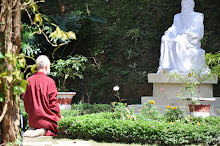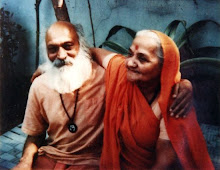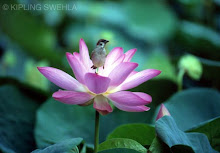Osho Commune says there is no Rajneesh Samadhi
By Abhay Vaidya
The ongoing dispute over Osho’s Samadhi at the Osho Commune premises in Pune has taken a serious turn with the Osho International Foundation (OIF) denying the existence of any samadhi of Osho at the commune premises.
After Osho – Bhagwasn Shree Rajneesh to some – died in January 1990, his ashes were buried in his bedroom at his Chuang Tzu residence, to create his samadhi (final resting place) inside the Koregaon Park premises of the Osho Commune.
Decorated with a magnificent circular chandelier, marble floors, walls, pillars and an epitaph on the Samadhi, this room became a very important place of meditation for his followers. The samadhi has a special significance in eastern cultures and a section of Osho’s followers and others want the sanctity of this place respected for all times.
Over the last decade, however, the administrators of the commune and the OIF trustees have been trying to erase all references to the Samadhi. This dispute over the Samadhi has now taken a serious turn with one of the key OIF trustees rejecting its existence on the premises of the Commune in an affidavit before the Charity Commissioner (Mumbai).
“It is absolutely incorrect that there is any Samadhi of Osho on the property owned by the trust. There was never any Samadhi or any structure as Samadhi of Osho,” says the affidavit by OIF trustee, Mukesh Kantilal Sarda, filed before the Charity Commissioner on 17 July, 2012.
Sarda has stated that Osho “never believed and, in fact, was opposed to any kind of personal worship or anyone to be immortalised by any temporal or non-spiritual aspect like structure, idol, etc.”
The affidavit, which runs into 34 pages, says that the contention that visitors to the Osho Commune “come to pay tribute and seek blessing from Osho’s Samadhi” is neither true nor correct as this contradicts Osho’s teachings.
Meditation in progress at Osho’s Samadhi. Pic Courtesy: Osho International Foundation.
“Osho’s instructions for the use of his bedroom were simply that it would be ‘a place for people to meditate’, and nothing else. The idea that Osho would want people to ‘pay tribute’ or seek ‘blessings’ from his ashes is pure fantasy of the traditional spiritual mind against which Osho spoke for 35 years,” Sarda states in his affidavit.
His affidavit is in response to a petition filed by three long-time followers of Osho, namely, Yogesh Thakkar (Swami Prem Geet), Kishor Raval (Swami Prem Anadi) and Nitin Phulphagar (Swami Nitin Bharati) who have challenged various activities of the OIF, including attempts to “gift” properties worth crores of rupees of the Osho Commune to an unknown entity in Delhi, Darshan Trust.
Armed with documents obtained under the Right to Information Act, 2005, Thakkar and Raval questioned the gift proposal and filed a petition with the Charity Commissioner, challenging the attempts by the OIF to gift prime properties of the Osho Commune to Darshan Trust.
The Osho Commune, renamed as the Osho International Meditation Resort after his death, is located at Koregaon Park and is part of other Osho properties spread on 25-30 acres of land and controlled by the OIF. The properties identified for gifting were described by Sarda in his application to the Charity Commissioner as “excess space”, not needed by the OIF. The OIF also maintained that it was finding it unaffordable to maintain and repair the properties identified for gifting, as it was not deriving any income from it.
The controversy over the Samadhi has erupted as a part of this dispute.
However, the OIF, controlled by a group of his foreign followers, has a different view. Represented by Sadhana Belapurkar (also known as Amrit Sadhana), the OIF management, went so far as to say in an interview published by The Times of India on 19 August 2007 that it was “a mistake” on their part to use the word “samadhi”. As she explained, “We do not call it a samadhi. It is called Chuang Tzu (hall) where Osho gave his first lectures after arriving in Pune in 1974. As per Osho’s wishes, his ashes were put in an urn and buried there.”
Like all samadhis in India, Osho’s admirers who respect him for his many incisive commentaries on spiritualism, his emphasis on meditation and acceptance of sexuality, want the samadhi to make accessible to the public. That has not happened so far.
These and many other issues were raised by Thakkar and Raval with the Charity Commissioner.
In an interview to this correspondent in 2007, Sadhana had said that the OIF was “doing its best” to “preserve Osho Chuang Tzu as Osho had asked. According to her, Osho had said, “You just put my ashes in Chuang Tzu under the bed. And then people can come in and meditate there.” She had said that the resort managers did not want to open “doors to any traditional misunderstanding of his wishes.”
The attempts by the OIF to water down the importance of the Samadhi has been worrying Osho’s followers for a long time. For example, one section of his followers draw attention to the repeated references to Osho’s Samadhi in a January 1990 video-recorded statement by Swami Prem Amrito (alias, John Andrew) who served as a personal physician to Osho. In that video, Amrito had recounted his conversation with Osho just before his death on 19 January 1990, and said that when he asked Osho, “What we should do to his Samadhi,” Osho had replied: “You just put my ashes in Chuang Tzu under the bed. And then people can come in and meditate there.”
Amrito again quoted Osho as saying that his bedroom “should be good for samadhi.” According to Sadhana, the place called “Chuang Tzu” was Osho’s bedroom and prior to that, a lecture hall where he gave his first discourses after arriving here in 1974.
In an earlier interview, Chaitanya Keerti, a former spokesperson of the commune, had said that a number of Osho’s followers were “suspicious” of the resort’s motives in discarding the term “samadhi.”
“We feel that it is a long-term strategy to break the emotional link that sanyasins have with Osho’s Samadhi and sell or lease Pune property in future,” Keerti had said. He had emphasised that the massive properties of the resort did not belong to the few people who were controlling it but to all Osho followers who had made contributions in the past.
http://www.firstpost.com/india/osho-commune-says-there-is-no-rajneesh-samadhi-396394.html





































